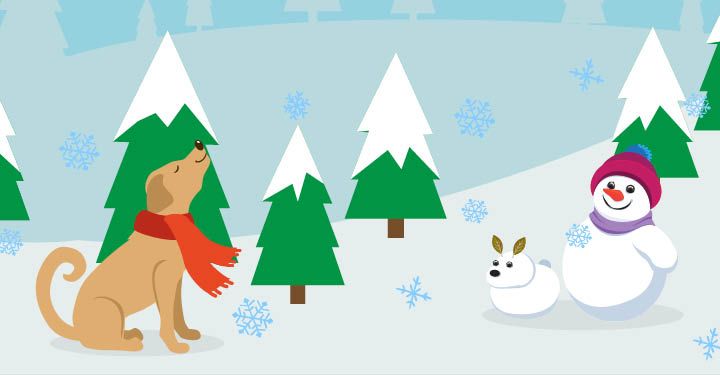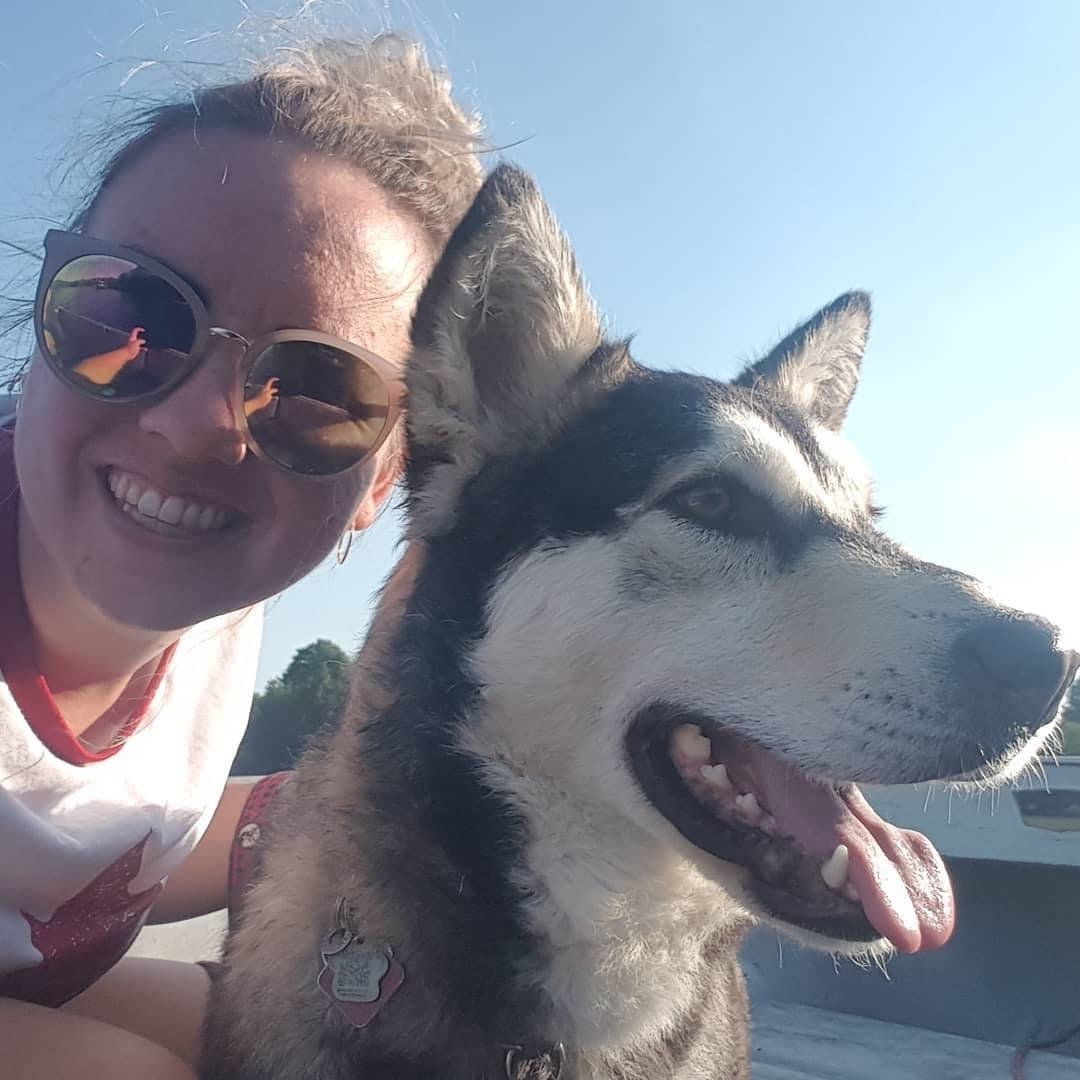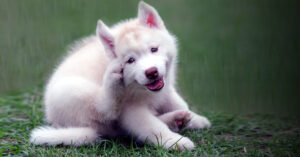Does your dog love the winter or would she rather cuddle up on the couch under a cozy blanket? Either way, you should be prepared to protect her when she ventures out into the elements. Winter care tips for your dog are important to keep her safe this season.
Many dog owners live with the misconception that because their pets have a coat of fur, they can tolerate the cold better than humans. This isn’t necessarily the case. Like us, these fur-coated creatures are used to the warmth of indoor shelter and cold weather can be as hard on them as it is on us humans. Whatever your viewpoint on winter, one thing remains certain: it’s a time when our beloved pets need a little extra care.
We have 15 winter care tips to keep in mind as you explore the winter landscape with your faithful four-legged friend.
Preventing Winter Health Risks
First … let’s talk about two serious cold weather conditions that you should take care to prevent.
Frostbite
Frostbite begins when the dog’s body gets cold. The body automatically pulls blood from the extremities to the center of the body to stay warm. The dog’s ears, paws or tail can get so cold that ice crystals can form in the tissue and damage it. The tricky thing to remember about frostbite is that it’s not immediately obvious. Watch for signs of pale or grey skin; the skin may also turn hard and cold. As frostbitten areas warm, they can be extremely painful. Severely frostbitten skin will eventually turn black and slough off.
Hypothermia
A second serious winter weather concern is hypothermia. This occurs when a dog spends too much time in the cold, gets wet in cold temperatures or when dogs with poor health or circulation are exposed to cold. In mild cases, the dog will shiver and her ears and feet may grow cold. As hypothermia progresses, she may show signs of depression, lethargy and weakness. As the condition worsens, her muscles will stiffen, her heart and breathing rates slow down, and she will not respond to stimuli. Severe hypothermia is life threatening.
Protecting your dog from frostbite and hypothermia is essential, so learn how to recognize the signs that your dog needs to come indoors to warm up.
Is your dog cold?
If it’s too cold for you to stand at the door without your coat, it’s probably too cold for your dog too, so pay attention to her behavior while she’s outdoors.
If you notice your dog whining, shivering or appearing anxious, or she stops playing and seems to be looking for places to burrow, then it’s time to bring her in.
15 Ways to Protect Your Dog in Winter
1. Let’s talk temperature!
Some dog breeds are blessed with thick fur that keeps them warm naturally, even in very cold temperatures, but dogs with thin coats may need to wear a sweater or coat when out for winter walks. A good coat should reach from the neck to the base of the tail and also protect the belly. But remember that coats will not prevent frostbite on the ears, feet or tail … so even with a cozy coat, don’t keep your short haired dog out too long in freezing temperatures.
2. Go outside when the sun shines
If your dog feels the cold, try to walk her in the late morning or early afternoon hours when temperatures are a little warmer, and avoid early morning or late evening walks. Spend time playing outdoors while it’s sunny; sunshine brings the added benefit of providing both you and your pet with vitamin D. Play fetch with toys, not sticks, which can cause choking and other injuries. So, if your dog likes to chew and chase, pack a Frisbee, ball or other safe toy and play together in the sun.
[Related] Is your dog getting enough sunshine? Check out this post.
3. Limit outdoor time in winter
Your family pet may love to spend time outdoors but in winter even the furriest dog can get cold. Ears, paws and tails are all susceptible to frostbite. Take your dog out frequently for walks, exercise and play … but when the temperature drops, don’t leave him outdoors for long periods of time. A good rule is to go out with him and when you’re ready to come in, he probably will be too. If he’s outside in your yard by himself, check often to make sure he’s not showing signs of feeling cold.
4. Cozy bedding
In addition to limiting your dog’s time outdoors on cold days, don’t let your pooch sleep on a cold floor in winter. Choosing the right bedding is vital to ensure your dog stays warm. Warm blankets can create a snug environment; raised beds can keep your dog off cold tiles or concrete, and heated pet beds can help keep the stiffness out of aging joints. Place your dog’s bed in a warm spot away from drafts, cold tile or uncarpeted floors, preferably in a favorite spot where she sleeps every day so that the area doesn’t feel unfamiliar.
5. Protect your dog from heaters
Dogs will often seek heat during cold winter weather by snuggling too close to heating sources. Avoid space heaters and install baseboard radiator covers to avoid your pet getting burned. Fireplaces also pose a major threat so please make sure you have a pet proof system to keep your heat-seeking pal out of harm’s way!
6. Moisturize
Dry and cold weather can do a number on your pet’s skin. Help prevent dry, flaky skin by adding a skin and coat supplement to her food. Coconut oil is a good natural moisturizer that can help keep your pet’s skin and coat healthy. If you find your pet’s paws, ears or tail are dry or cracking, you can also apply coconut oil topically as needed.
[Related] Coconut oil has a ton of other great health benefits too! Find out what they are here.
7. No overfeeding please!
Although dogs may need an extra layer in winter, make sure it comes from a coat and not a layer of fat. Cold temperatures may even bring on lazy behavior and the need for fewer calories. Be attentive to your dog’s activity level and adjust her calories accordingly. A high quality, whole foods, preferably raw meat based diet will help ensure a healthy coat and good energy for the cold winter months.
8. Keep your dog hydrated
Dogs can dehydrate just as quickly in winter as summer. Although many dogs eat snow, it’s not an adequate substitute for fresh water. If your dog spends time outdoors in your yard, make sure she has access to a water bowl, check it often and break ice that forms on top.
9. Groom your dog
Your dog needs a clean, well-groomed coat to keep her properly insulated. This is especially important if your dog spends a lot of time outdoors. After bathing, dry your dog thoroughly, especially before allowing her outside.
10. Paw care is a must
Just as we tend to develop foot cracks in winter, dogs can also suffer from cracked pads. If your dog has furry feet, trim the hair that grows between her pads to prevent ice buildup between the pads. Winter salt on city sidewalks can also burn your dog’s pads and is toxic, so after walks around the neighborhood, rinse or wipe your dog’s paws to remove any salt – you don’t want her licking it off. If your dog shows signs of discomfort when walking outside on frozen or salted surfaces, consider using dog booties to protect her paws.
[Related: How To Find Pet Safe Ice Melts For Happier Paws]
11. Snow removal
Snow can be a lot of fun but it can also be dangerous for your dog. Snow piled near fences offers your dog escape routes that even well-trained dogs often can’t resist. When you clear snow in your yard, pile it away from fences to prevent your dog from climbing over. Snow and ice often accumulate on rooftops and if the sun is out or as temperatures rise, this accumulation can slide and injure your dog. If you can’t clear the snow from the roof, keep your dog away from the roof overhang to prevent injury.
12. Watch where your dog plays
Although your dog is likely having a great time outdoors, take frequent indoor breaks for water and warming and don’t ever stay out too long. If you’re walking or playing in unfamiliar areas, keep your dog close. It’s easy for her to venture onto unsafe surfaces such as frozen ponds or lakes. These may be covered in snow and not easily visible.
13. Avoid exposure to toxins
With winter comes antifreeze. Antifreeze tastes sweet and dogs (as well as some children!) will readily lick or drink it. Antifreeze is extremely toxic and just a small amount can be fatal. Keep your dog out of the garage and off the driveway where she may encounter antifreeze or other harmful chemicals.
[Related] Help prevent exposure to antifreeze and protect your dog. Read these tips.
14. NEVER leave your dog unattended in the car, no matter what the season
Just as cars can get dangerously hot in summer, freezing cold temperatures are equally dangerous for your dog in winter. Leaving the car running involves additional risks, including carbon monoxide poisoning if the car is parked in a garage. Leave your dog at home when you go out to run errands.
15. Special care for seniors
Cold weather will often aggravate existing medical conditions in dogs, particularly arthritis. It’s very important to maintain an exercise regimen with your arthritic dog, but be mindful of slippery surfaces and make sure your dog has a warm soft rest area to recuperate after activity. If you don’t already give your senior dog a natural joint supplement to lubricate the joints and ease the discomfort of arthritis, you may want to consider adding one in winter. Just like people, dogs are more susceptible to other illnesses during winter weather.
Harsh winter weather brings a wide variety of concerns to responsible dog owners. Bitter cold, numbing wetness or biting winds can cause discomfort for that special dog in your life. Paying special attention to your loyal friend’s wellbeing during the winter season will ensure that you both enjoy the season to the fullest.
Keep these winter care tips in mind and enjoy everything winter has to offer. And don’t forget that winter cuddles with your canine buddy are a great way for everybody to keep warm!












